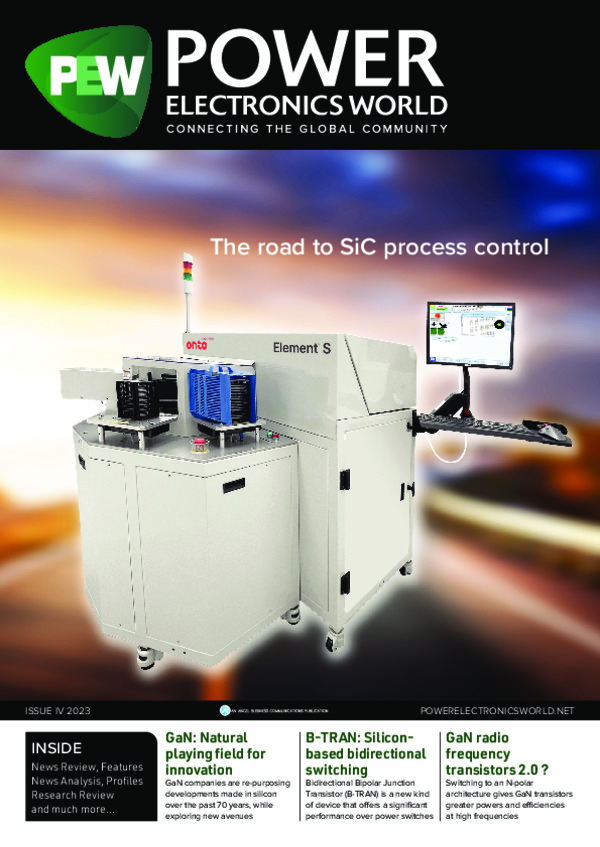
GaN: A natural playing field for innovation

GaN companies are re-purposing developments made in silicon
over the past 70 years, while exploring new avenues for innovation and
integration.
Professor Florin Udrea, CTO of Cambridge GaN Devices, gives his personal view on the extraordinary potential of GaN.
There are many ways to define innovation but the Greeks are always a good place to start. Philosopher Socrates advised: “The secret of change is to focus all of your energy, not on fighting the old, but building on the new.” Addressing the same theme from a different angle, Albert Einstein is alleged to have said: “The definition of insanity is doing the same thing over and over again but expecting different results.”
I personally believe in creating a culture of innovation — one of the founding principles of our company. If an organisation encourages creative thinking from all its employees, new ideas will emerge, challenging the old, traditional ways. Creativity sparks further creativity and great strides can be made.
All my experience - and my instinct - tells me that innovation results from a deep knowledge base. Before Cambridge Gan Devices, I ran a team at Cambridge University for more than 30 years researching different materials and technologies. Many ideas - different configurations, contexts and geometries - that were developed for silicon are now being applied to GaN. For example, superjunction technology and membrane technology are re-emerging as possibilities for GaN.
Of course, there are brand new concepts that have been developed purely for GaN too. It is this thorough and detailed understanding and appreciation of materials and device physics that is enabling new power applications based on GaN.
With our background, GaN was a natural playing ground. It is a very interesting material, but of all the materials I have studied - silicon, SiC, diamond, GaN - by far the most difficult is GaN.
GaN is not only a wide bandgap material but its incorporation in a heterojunction is what makes it special. Indeed, the use of a GaN/AlGaN structure, enables an interface quantum layer (2DEG) with concomitantly high electron charge ( ~ 1e13cm-2 ) and high mobility ( ~1700 cm2/(Vs)).
So, on one hand, GaN companies re-purpose all the developments that have been made in silicon over the past 70 years, and on the other hand GaN offers new avenues for innovation.
Furthermore, as opposed to SiC, GaN enables integration. So, for example, intelligence, protection and sensing can be produced in GaN and delivered on the same chip as the HEMT. Of course, this is also possible in silicon, but only at low power. GaN permits integration at much higher power levels and much higher frequencies.
Will GaN replace silicon in other markets? Well, for applications where high power and high frequency are required, GaN is the best material. But digital electronics will remain based on silicon, because silicon has both n-channel and p-channel transistors and can be scaled down to nm levels.
GaN has the 2DEG structure which is fantastic for making an n-channel transistor, but today there is no reliable equivalent hole gas structure that would enable the creation of a p-channel transistor in GaN. And because recombination times are very small, bipolar devices are also not possible in GaN, Therefore, for the time being at least, GaN’s best prospect is as HEMT device only. But for this purpose, GaN is a fantastic, marvellous material. It will be used for power applications from maybe 40V to about 1.2kV and is going to dominate in high-frequency applications. GaN is also interesting for RF and there are opportunities in optical applications such as LEDs.
2x pictures of the ICeGaN H2 HEMT
A novel and innovative approach to the GaN market
Cambridge Gan Devices (CGD) has taken a completely novel – innovative – approach to the GaN market: we optimise the use of GaN integration. CGD adds intelligence, sensing and protection, making the gate extremely reliable, but at the same time keeping the simplicity of a highly efficient transistor.
This approach supports the two claims we make about our ICeGaN GaN technology: that is easy to use, because our transistors can be driven in the same way as a silicon or silicon carbide device; and that it matches or even surpasses the reliability of silicon and silicon carbide.
Let’s break that down a little.
Unlike other companies that try to integrate the actual HEMT driver with the HEMT itself in one IC, CGD integrates the Miller Clamp and HEMT and an auxiliary device to regulate the voltage from a control pin (external gate) to the actual gate of the HEMT.
The Miller Clamp regulates dv/dt which is the most critical and complex issue to handle when driving a GaN HEMT. This also allows more relaxed design rules regarding how far the driver can be placed from our ICeGaN device.
Given the above, it is perfectly possible to take a standard silicon MOSFET driver IC and use it to drive CGD’s ICeGaN HEMTs without any extra circuitry. To get the best performance from an ICeGaN HEMT however, especially at high frequency, an optimised driver will be required, but all the complex slew rate design issues have been solved.

